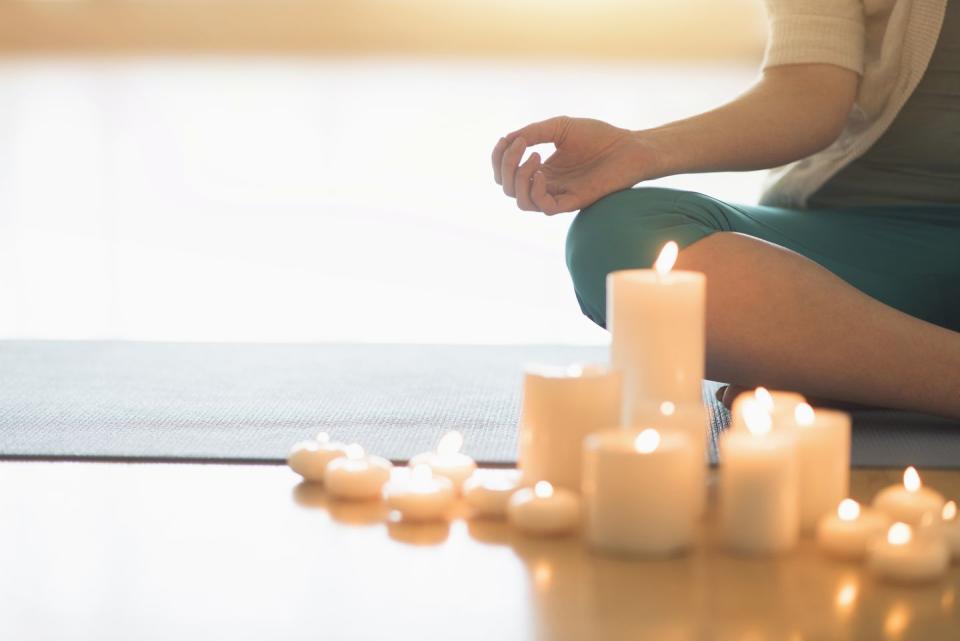This Simple Guide Will Teach You How to Meditate, Even When Your Mind Wanders

"Hearst Magazines and Yahoo may earn commission or revenue on some items through the links below."
We’ve all been there: The clock strikes midnight, and our thoughts race on as if we’d just walked into the office with our first cup of coffee. Sleep? Never heard of her, minus a few quick minutes of shut-eye in between the tossing and turning.
This scenario is all too common for many. It’s incredibly challenging to calm down a racing mind after a full day of working, parenting, and taking care of other responsibilities, not to mention trying to survive a pandemic. The good news is you can train your mind to calm down so you can get a proper night’s rest, improve focus at work, and relieve stress—all through the practice of meditation.
“In a world increasingly built on falsehoods, the need to establish an infallible inner GPS is paramount to one’s safety and sanity,” says Kelly Morris, meditation teacher and founder of The Infinity Call. “Meditation can provide you with the instant reset needed to move forward coherently and gracefully.”
What is meditation, exactly?
“Meditation is the practice of intentionally awakening to our thoughts, feelings, and bodily sensations in the mental space of observance and acceptance,” says Andrea Parsons, M.S.W., L.C.S.W., a psychotherapist in both private practice and at one of the nation’s largest HMO. “Meditation asks us to be the observer of our thoughts, feelings, and bodily sensations rather than the critic of them.”
A daily meditation practice allows us to get clear about what we’re experiencing by directing our focus to our inner world, Parsons says. Many of us have been taught to dismiss or reject certain emotions or thoughts, which creates separation from oneself. Practicing meditation helps us to reconnect with ourselves.
Because meditation involves focusing inward with the mind and being an observer of our thoughts, the practice results in a number of psychological and physical benefits, such as improving our ability to problem solve and reducing stress hormones in the body. And you don’t have to spend hours sitting crossed-legged to reap the benefits.

The benefits of meditation
Just a few minutes of meditation a day can have profound effects on your health. “Meditation is an endless fountain of benefits and rewards, from improved sleep to reduced loneliness to better skin,” Morris says.
Meditation improves our ability to problem solve.
Our problem-solving abilities can become impaired when our minds are distracted or we are tired, but meditation can help bring focus and alertness. “Meditation keeps us aware of what is happening in the moment,” Parsons says. “This allows us to respond more effectively to our environment compared to when our mind is replaying the past or anticipating some type of future loss.”
Meditation reduces stress.
When we become stressed, our bodies activate the stress response, in which the nervous system releases a flood of stress hormones including adrenaline and cortisol. “Activation is when we notice a physiological response in our bodies as the result of stress hormones being released, such as heart racing, sweaty palms, upset stomach,” Parsons explains. “We often activate the stress response because of catastrophic thinking or replaying a past upset.” People who meditate regularly can avoid activating the stress response, she says, adding that meditation helps us stay present.
Meditation may even help boost the immune system.
“Participants of a study who approached unwanted thoughts and feelings non-judgmentally rather than fighting them off showed more activation in their brain’s region of positive emotion,” Parson says. “These participants also produced more antibodies when given a flu vaccination compared to other participants.”
There’s no “proper” way to meditate.
Many are discouraged from meditating because they believe they have to be taught or they aren’t doing it right. “There are as many ways to meditate as there are people in the world,” Morris says. “Much like the proverbial snowflake, everyone is slightly different in their needs, outlooks, and capacities. As such, there is no singular, ‘proper’ way to meditate.”
Common misconceptions around meditation include that it’s too hard, boring, mysterious, selfish, and only belongs to Eastern cultures, Morris says. But this is not the case. There are endless ways to meditate, ranging from beginner to advanced practices. The six main categories of meditation are mindfulness meditation, focused meditation, spiritual meditation, mantra meditation, and Transcendental Meditation (TM):
Mindfulness meditation involves paying attention on your thoughts and observing them without judgement.
Focused meditation is when you concentrate using any of the five senses, like breathing or staring at a candle flame.
Spiritual meditation is used in religions, when participants reflect on a deeper connection or purpose.
Mantra meditation is when you recite a mantra over and over again, such as “Om.”
Transcendental Meditation builds off of mantra meditation in which the participant is given a custom mantra from a TM instructor.
Movement meditation involves moving the body in some way that brings peace, such as qigong, walking, or yoga.
Other types of meditation include sound bath meditation, visualization, Vipassana meditation, chakra meditation, and many, many more. You'll want to familiarize yourself with the various methods, and then begin with the one that sounds the most comfortable and accessible for you. Because meditation is so customizable, you're bound to find something that works!

What should you think about when meditating?
Whether you’re a beginner or an advanced practitioner, the mind will do nothing but wander, Morris says. “For most people, the mind has been trained to be discursive since birth. It’s normal to entertain five or six thoughts at the same time and to even be rewarded for it—the common vernacular is ‘multitasking,’” she explains. “Single-pointed concentration, though, makes the brain happy.”
Beginners are often frustrated with the mind’s tendency to wander during meditation. That’s because they are assuming that the mind should be “silent” when they’re “successfully” meditating. “This simply isn’t true, and it prevents many people from exploring a meditation practice that has the capacity to improve their lives on every level,” Morris says.
Ultimately, there are going to be thoughts that pour in while you’re meditating, but the key isn’t to try and silence them. Instead, just observe them. “Meditators, like everyone else, are forced to think whatever thoughts the Thought Army decides. We are not in charge,” Morris explains. “Over time, the meditator realizes that they aren’t thinking, that their thoughts are actually thinking them. We don’t generally choose our thoughts, although we may think we do. It helps to remember that meditation isn’t an effort to ‘not think.’”
When (not if!) the mind wanders beyond control, Parsons recommends gently bringing it back with your breath or bringing your attention a focal point such as a candle or a sound. Morris adds that feeling into the sensations of the body or the ground beneath you can also help you recenter.
How to start a meditation practice
Like everything else, meditation takes practice. “I’ve found that most people will read an article about meditation and attempt to sit down with the best of intentions, but they will only last for a few minutes at most,” Morris says.
“To maximize the likelihood of staying with meditation, I recommend starting with three minutes in the morning or night,” Parson explains. If you have a history of trauma, Parsons recommends consulting with a mental health professional, as meditating can exacerbate symptoms in survivors. “Gradually, work your way up to more minutes of meditating. Just as an athlete or musician attains their level of skill after years of practice, we need to gradually build our meditation practice,” she says.
Morris suggests working up to 10 to 20 minutes of meditation a day. “If you find a comfortable seated position, one can sit for 10 to 20 minutes. It’s the content of the mind that makes people leap up and decide 10 or 20 minutes is way too long,” she says. “Beginners who want to explore the possibilities of meditation can engage with this simple guide: Wake up, go to the bathroom, sit down. Don’t check your email, text messages, DMs, social media pages, the news or anything else. Simply wake up and directly sit before the day takes its toll.”

Meditation resources for beginners
There’s an abundance of resources for assistance with meditating at home, including meditation cushions and tools to help with focus such as Mala Collective’s Mala beads. Parsons recommends referring to instructors, like Zen Master Thich Nhat Hanh, Zen priest angel Kyodo williams, Jack Kornfield, Ph.D., Jon Kabat-Zinn, Ph.D., and Tara Brach, Ph.D. “Each practitioner has their unique approach, so checking out several resources can help you find the best fit for you,” she says, adding that all sites have meditations.
You can also download the app Insight Timer. “I respect their commitment to offering over 30,000 free meditations,” Parsons says. “I also recommend the Liberate Meditation app, which is a subscription-based app created by and for Black, Indigenous, and People of Color.” Other meditation apps include Calm, Headspace, and Mindvalley.
Parsons says you can even refer to podcasts. “I recommend 10% Happier by Dan Harris, which is offering a Coronavirus Sanity Guide for free,” she says. “I also think that The Rubin Mindfulness Meditation podcast is a unique form of meditation with rotating teachers guiding meditation that’s focused on artwork.”
If you’re looking for more specific training, check out Morris’ sessions at The Infinity Call. “The Infinity Call is a grounding, virtual meditation practice dedicated to healing the lives of all those who identify as women around the world by reconnecting them and their identities to the Earth,” she says. Lastly, you can always try group meditations, at studios or in person. “That tends to help people remain more focused compared to meditating alone,” Parsons says. Check to see if a studio near you is open before scheduling a class.
Your meditation practice will be unique to you. However you cultivate one, know that you have an ample amount of resources, support, and guidance to get started. Keep in mind that beginning a meditation practice can be difficult, but the psychological and physical benefits make it well worth it to stick with it.
Go here to join Prevention Premium (our best value, all-access plan), subscribe to the magazine, or get digital-only access.
FOLLOW PREVENTION ON INSTAGRAM
You Might Also Like

